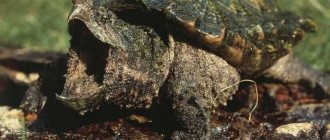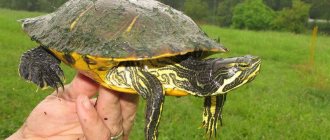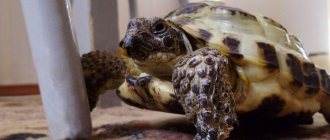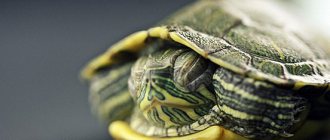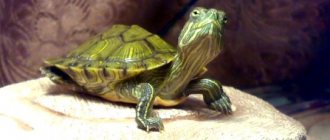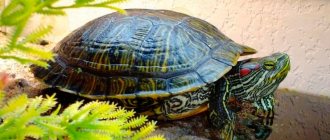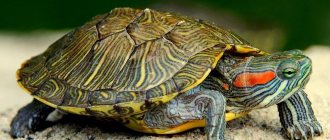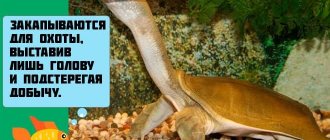Habitat of red-eared turtles
Trachemys scripta's habitat is primarily southeastern America and the adjacent region of Mexico: from southwestern Virginia through Florida, Alabama, Mississippi, Louisiana and Texas to Mexico. To the north, the habitat extends to the ends of Kentucky, Tennessee, Ohio, Indiana, Illinois and Iowa, and to the west to Kansas, Oklahoma and New Mexico.
Red-eared slider sizes
Trachemys scripta elegans predominates predominantly in the western and central parts of this range. Occupying the Mississippi Valley from Illinois through eastern New Mexico west to the Gulf of Mexico.
Trachemys scripta scripta is predominant in the eastern part of its previously described range, ranging from southeastern Virginia to northern Florida. It should be noted here that an intergradation zone of Ts elegans and Ts scripta is formed in Alabama.
Trachemys scripta troostii has the smallest range of occurrence and is found in the upper Cumberland and Tennessee rivers. From southeastern Kentucky and southwestern Virginia through Tennessee to northeastern Alabama.
Trachemys scripta occurs in a wide range of freshwater habitats including rivers, ditches, swamps, lakes and ponds. Quiet reservoirs with a soft bottom and an abundance of aquatic vegetation.
Reproduction of lizards.
The mating season of lizards always occurs in spring and early summer. Large species of lizards breed once a year, small ones - several times per season. Rival males approach each other sideways, trying to look larger. The smaller ones usually give up without a fight and retreat. If the lizards are males of the same size, a bloody fight ensues, during which competitors bite fiercely. The winner gets the female. An imbalance in the sex ratio in some lizard species leads to parthenogenesis, when female lizards lay eggs without the participation of a male individual. There are 2 ways of lizard reproduction: laying eggs and viviparity.
Females of small species of lizards lay no more than 4 eggs, while large ones lay up to 18 eggs. The weight of an egg can vary from 4 to 200 grams. The egg size of the world's smallest lizard, the round-toed gecko, does not exceed 6 mm in diameter. The egg size of the largest lizard in the world, the Komodo dragon, reaches a length of 10 cm. Future “mothers” bury their clutch in the ground, hide it under stones or in holes. The incubation period depends on climatic conditions and lasts from 3 weeks to 1.5 months. Having hatched, newborn lizard cubs immediately begin an independent life without parental participation. The pregnancy of viviparous lizards lasts 3 months; the embryos of the northern species overwinter safely in the womb. The lifespan of a lizard is from 3 to 5 years.
Lizards exterminate insect pests, thereby providing invaluable benefits to humanity. Many exotic species are popular terrarium pets: bearded dragon, true iguana, Yemen chameleon and others. With proper care, lizards reproduce well in captivity, increasing the artificial population.
- ← Big pig
- Aquarium swordtail fish reproduction →
Description of red-eared turtles and species
Red-eared slider photo
Red-eared turtles are born with a shell length of only 30 mm and have a very attractive bright color. In the first 1.5 years, the turtle reaches a size of 75 mm. After which the growth rate decreases and on average the growth is 10 – 15 mm per year. Individuals are characterized by the presence of distinct red or yellow-red spots on both sides of the head. The shell and skin are olive, olive-brown or green with yellow stripes. The shape of the shell is oval. Legs with large claws and membranes between the toes.
This species cannot be classified as ornamental, since the average size of the freshwater red-eared turtle is from 125 to 289 mm, however, there are records of individuals reaching a size of 350 mm. In the wild, the red-eared turtle lives for about 20 years; in captivity, it can even live up to 40 years.
Over time, the turtle's large size and lifespan embarrass buyers, who are unable to keep the turtles in captivity for long periods of time and release them into the wild.
Trachemys scripta elegans.
Red-eared slider photo
The length of the carapace of Trachemys scripta elegans reaches 280 mm. There is a wide red stripe on the head and narrow stripes on the chin. On each costal carapace there is a transverse yellow stripe. Plastron with a large spot on each scute.
Trachemys scripta scripta.
Red-eared slider photo
The length of the carapace of Trachemys scripta scripta reaches 270 mm. There is a yellow postorbital spot on the head, connected to a stripe on the neck. Each costal carapace has a yellow stripe. The plastron is yellow with spots on most of the front scutes.
Trachemys scripta troostii.
Red-eared slider photo
The length of the carapace of Trachemys scripta troostii reaches 210 mm. The head has a narrow yellow postorbital stripe and wide chin stripes. Each costal carapace has a yellow transverse stripe. Plastron with a pattern of “eyes” or small black spots.
Description
Name (Rus): Red-eared Name (Latin): Trachemys scripta
The wrinkled shell of an adult red-eared turtle can reach a length of 60 cm, depending on the subspecies. The spot behind their eyes is not only bright red, but also bright yellow. In general, the colors of these turtles are extremely diverse, and in addition, they change greatly with age. Old animals can even become completely black, while young animals can become bright green. The plastron of turtles is bright yellow with dark round spots. During the first 1.5 years of life, they are able to grow up to 7.5 cm, then growth slows down and the turtle grows 1-1.25 cm per year.
Habitat
From southern Virginia to northern Florida and Kansas, Oklahoma and New Mexico in the west (USA), Mexico, all of Central America, northwestern South America (northern Colombia and Venezuela). The species is introduced to southern Florida, Arizona, Guadeloupe, Israel and South Africa. They live in small lakes and ponds with low, swampy shores.
Nutrition
Young turtles are fed every day, adults 2-3 times a week. You have to work out the amount of food yourself, depending on how much the turtle eats. Typically, for babies the volume of food is 2-3 pieces of 1 cm3, for older adults 2-3 pieces of 2-3 cm3. The food should be raw and at room temperature. Young turtles are PREDATORS, adults are omnivores (that is, in addition to animal food, they also eat plant food). The main food is FISH! It is best to give live small fish that can be immediately introduced into the aquarium. Types of food: FISH (lean and different types - hake, cod, gobies, thalassa, etc.), MEAT (chicken, pork, beef liver), INSECTS (daphnia crustaceans, gammarus, bloodworms, earthworms, legless crickets, wood lice, locusts without legs, beetles), OTHERS (small freshwater snails, shrimp, squid, tadpoles, frogs), PLANTS (lettuce, nettle, dandelion leaves, cabbage, duckweed and other aquatic plants, also slices of carrots, apples, cucumbers). The turtle should receive vitamins and mineral supplements. For these purposes, either calcium-containing fertilizers and vitamins (Wardley and other companies) are added to the feed, or a complete and varied feed is given. It is also advisable to place a mineral block neutralizer for turtles in the aquarium.
Reproduction
Turtles become sexually mature in nature at 6-8 years of age, and in captivity at 4 (males) and 5-6 for females. In March or April, the mating season begins: each male, having met a female, manages to end up right in front of her face, and very close. The female swims forward, and the male swims backward, tickling the female’s chin with his long cats. The eggs of red-eared turtles are no larger than 4 centimeters. To lay them, the female leaves the reservoir and comes to land. Having found a suitable place, she heavily wets the ground with water from the anal bladders. After this, it begins to dig a hole with its hind legs - a nest. The nests of red-eared turtles look like a ball with a diameter of 7 to 25 centimeters, in which females lay 5-22 (6-10) eggs, which they then bury. The incubation temperature is from 21°C to 30°C and the duration is 103-150 days. At an incubation temperature below 27°C, males hatch, and at temperatures above 30°C, only females hatch.
Keeping red-eared turtles at home
Red-eared turtles beautiful photo
Red-eared turtles are unpretentious creatures, however, like all living things, they need good maintenance and care. Despite the fact that turtles spend most of their lives in water, their aquarium house cannot exist without land. Therefore, you need to select an aquaterrarium divided into two zones: land above and water below.
For an adult red-eared turtle, an aquarium of 100 - 150 liters will be sufficient, for a young one 50 liters will be enough. Land must make up at least 25% of the total area. On land, you can pour earth or gravel, provided that the soil does not come into contact with the aquatic environment. The exit to land should be a shore with a gentle, non-slip slope. The erected artificial island must be 20 - 30 cm below the top edge of the aquarium, otherwise the animal can get out and run away.
The water level should be greater than the width of the turtle's shell so that the turtle can easily roll over if for any reason it ends up on its back. Due to the fact that turtles feed exclusively in water, good filtration and regular mandatory water changes 1-2 times a week are necessary. Tap water is not dangerous, but it is better to defend it. It is unacceptable to keep reptiles in dirty water, as this can lead to various diseases.
Red-eared turtle aquarium volume photo
The water temperature is maintained within 20 - 250C, the air temperature on the shore is about 31 - 330C. Above the island it is necessary to install an incandescent lamp of 40 - 50 W, since turtles like to bask on land, and an ultraviolet lamp for reptiles - 10% UVB for babies and 5% for adult healthy turtles; regular dosed ultraviolet irradiation is especially necessary for small turtles. Turtles love to bask on land, receiving enough ultraviolet radiation necessary for activity, good metabolism (digestion of food and stomach function) and prevention of rickets.
Lamps are hung at a height of at least 20–25 cm to prevent burns to the turtles’ eyes. Both lamps should be on for 10 - 12 hours a day; they are turned off at night.
Red-eared slider photo
German herpetologists recommend using the following water temperatures and lighting durations when keeping red-eared turtles throughout the year.
Red-eared slider photo
To keep your turtle's aquarium clean, we recommend using Prodibo Aqua'Turtle - a kit for effectively combating unpleasant odors in aquaterrariums where aquatic turtles live.
It combines two different products: - Aqua'Turtle Odor - eliminates unpleasant odors in the aquarium. — Aqua'Turtle Bacter is a biological preparation that consists of various specific strains of bacteria that are characteristic of reservoirs with reptiles. They provide clean water in the aquarium, suppressing the development of pathological microflora.
Compatibility of red-eared turtles. Newborn red-eared turtles can be kept with small fish.
However, as turtles grow older, they are able to eat fish, so we select neighbors with character, for example, cichlids.
Climate
To be healthy, your pet red-eared turtle needs warmth and light. In the aquaterrarium it is necessary to install artificial lighting , daylight and ultraviolet. To prevent rickets, turtles should be irradiated with a UV lamp for 3–4 minutes 3 times a week. For adult turtles, the time is increased to 2 hours a day.
The water temperature should not fall below 20 °C. The norm is from 22 to 28 °C. If the lamp is not enough to warm up the water, you should install a heater. You cannot place the aquaterrarium in the sun, but you can let the turtle out for a walk. At the same time, she should have the opportunity to go into the water and into the shade.
What to feed red-eared turtles?
Red-eared turtle diet
Red-eared turtles are omnivores and love to eat a wide variety of plants and animals: filamentous algae, snails, terrestrial insects, crustaceans, small vertebrates, etc.
However, the feeding frequency of turtles varies depending on age. So young turtles are fed daily, but adults only 2-3 times a week.
All young Red-eared turtles are primarily predators, therefore they need live food for active growth, which they are fed once a day (neither 2 nor 3). In addition, the aquarium must contain live plants (algae, lettuce leaves) as plant food. Adult Red-eared turtles (over 7 cm) are fed 3 – 4 times a week, and the amount of plant food approaches 50%.
Proper and nutritious nutrition for red-eared turtles will keep them healthy and playful for many years. The diet of domestic turtles must include plant foods (such as basil, aloe, oregano, peas, balsam, figs, clover, coleus, calendula, nettle, onions, dandelions, petunias, rose petals, barley, rose hips, cyperus, Kalanchoe, fern, hibiscus, lawn grass, coffee, plantain), vitamin and mineral supplements, fish (such as cod, hake, thalassa) and meat.
Red-eared turtle eating
But not all plants are useful for turtles, there are also poisonous ones (monstera, epipremnum, philodendron, anthurium, silent, acalyph, croton, jatrophe, azalea, delphinium, crocus, morning glory, lily of the valley, lupine, periwinkle, oleander, juniper, nightshade, ficus, philodendron, shefflera), some of which cause great harm to health even after touching. In some cases, eating these plants leads to disruption of the nervous system and gastrointestinal tract.
You should not include in the red-eared turtles’ diet such foods as are so familiar to us, such as: meat (minced meat, sausages, beef, pork, lamb, chicken, etc.), fatty fish, fruits, bread and cheese.
Please note that feeding aquarium fish and aquarium turtles must be correct: balanced and varied. This fundamental rule is the key to their successful maintenance.
Currently, dry food is, of course, popular and popular food for fish and turtles. For example, you can find food from Tetra, the leader of the Russian market, on aquarium shelves all the time and everywhere, having a range of food “for every taste.” Tetra’s “gastronomic arsenal” includes individual food for a specific type of fish: guppies, goldfish, cichlids, loricariids, labyrinths, arowanas, discus fish, etc. Tetra has also developed specialized foods, for example, to enhance color, fortified, or for feeding fry. You can find out detailed information about all Tetra feeds on the company’s official website - here .
It would not be amiss to note that when purchasing any dry food, you should first of all pay attention to the date of its manufacture and shelf life, try not to buy food in bulk, and also store the food in a closed state - this will help to avoid the development of pathogenic flora in it .
Breeding turtles
A turtle's readiness to reproduce depends on its size. The length of males should be more than 10 cm, and females should be more than 12-13 cm. The male begins to court the female. He swims near the female, pokes his muzzle into her muzzle and waves his paws. In the wild, turtles breed in March and June, and at home at any time of the year.
For a pregnant turtle, it is necessary to provide a place where it will lay eggs. There may be two dozen eggs in a clutch. In good conditions there are 3-4 clutches per year. If the female is ready to breed, she becomes active, tries to dig something and tries to get out of the aquarium. At the same time, he spends most of his time on the island. If the female lays one or two eggs, then make her a nest. And remember that most likely she carries the remaining eggs further.
If the turtle does not lay eggs, but continues to carry them, this can lead to the development of an infection and its death. If the eggs are still not laid, then immediately take her to the veterinarian.
Baby just hatched from an egg
Reproduction and sexual differences of red-eared turtles
Red-eared slider breeding
Red-eared turtles reach sexual maturity at the age of 4–5 years in captivity and 6–7 years in the wild. Turtles living in terrariums mate without paying much attention to the season, while in nature the mating season takes place from March to July.
Males are generally smaller than females and have a long, thick tail. However, if the red-eared turtles are of different ages, then it is not always possible to determine the sex only by size , in this case the following factors must be taken into account: the male’s eye spot is more pronounced, the claws on the front legs are longer, the lower part of the shell is concave (in the female flat).
The mating process is accompanied by a mating dance. The male approaches the female's head. The female swims forward, and the male swims backward, stroking the female’s chin with his long claws. If the female is not against mating, she accepts these advances, otherwise the male is driven away, even to the point of using physical force.
Pregnancy of a red-eared turtle lasts for 2 months, but the period can be extended if the female cannot find a good place for laying.
To lay a clutch, the female needs to dig a nest on the shore of a reservoir. Interestingly, it can move long distances, up to 1.5 km, in order to find the best place for a nest. The nest has the shape of a jug up to 12 cm deep. Depending on age, red-eared turtles can make up to 6 clutches per year with a total number of 30 eggs (which is from 6 to 11 per clutch). The size of the red-eared turtle egg is about 4 cm. The incubation period lasts for 59 - 150 days, because Hatching time directly depends on temperature. So at temperatures from 22 to 30 ° C, the incubation period ranges from 55 to 80 days. The temperature in the nest directly affects the sex of turtles; females are born at temperatures of 29 °C and above, and males are born at 27 °C and below.
To get out of the egg, newborn red-eared turtles pierce the shell with an egg tooth, which falls off after an hour. All babies have a small pouch on their abdomen with the remains of incubation provisions: when it falls off, it leaves a quickly healing wound.
Keeping a turtle at home
To keep a turtle you will need a spacious aquarium from 150 liters to 200 liters. If you keep it in a smaller volume, it will tighten and become distorted. Such requirements may seem inadequate at first, but it is worth remembering that the animal is growing and needs a place to live. The aquarium must have an island where the turtle can crawl out to warm itself. The island must occupy ¼ of the aquarium and meet the following requirements:
- The temperature on the artificial shore should be 10 degrees higher than in the water.
- One side of the island should be slightly submerged.
- Be safe, that is, do not emit harmful substances when heated.
- The island must be stable so that the animal cannot turn it over.
- Have a textured surface.
The presence of soil in the aquaterrarium is not necessary. It is placed only as decoration. But, under no circumstances should you use fine soil, as the animal may choke on it and die.
Interesting facts about red-eared turtles
Red-eared slider photo
— Today, the red-eared turtle is one of the most popular inhabitants of the home aquarium. In European countries, promotions are regularly held that urge lovers not to purchase these turtles, because their population is rapidly declining. In Switzerland, a special center has even been created where you can bring a grown turtle.
— Turtles have lived on earth for almost 200 million years, they appeared long before birds, crocodiles, mammals and even lizards.
— In Russia, freshwater turtles with a characteristic red spot on the head are called red-eared, and in Germany – red-cheeked.
— Red-eared turtles have a well-developed sense of smell, vision and touch, and their shell contains a large number of nerve endings.
— The lifespan of red-eared turtles is 30 (40–45) years, European marsh turtles are the same, sometimes even 80 years.
— Fishermen look for clutches and use turtle eggs as excellent bait for fish.
— Young turtles are caught in untold quantities (especially in the Mississippi Valley) and transported to pet stores throughout the United States.
— Turtles are often aggressive and can bite both people and other turtles. Red-eared turtles, accustomed to being handled, often do not bite.
— And in some Asian countries, it is customary to release turtles into the wild environment as part of the tradition of the Buddhist ceremony of mercy to increase positive karma, respect for the Buddha and repentance for sins.
Author Alexander Isakov
Water in the aquaterrarium
The turtle spends most of its time in water. This is where she sleeps, eats and defecates. The water quickly becomes dirty and begins to smell unpleasant, so the aquarium definitely needs a good filter and frequent water changes.
There should be enough water in the aquarium for the turtle to swim and roll over. In general, the more there is, the better. The water being replaced must be settled. Comfortable water temperature is 22-28 degrees. If its temperature drops below, install a heater.
How to determine the age of a land turtle
There are two ways to do this:
Calculating age from shell length.
At birth, these reptiles have a shell of only 3 cm in length (this is an approximate figure). For each year lived, it lengthens by about 2 cm. Thus, to determine the age of a land turtle, you need to subtract 3 cm from the previously measured length of the shell and divide the resulting difference in half. For example, let's calculate the age of a turtle with a shell length of 19 cm: (19-3):2=8. Eight is the approximate age of the reptile.
It is known that during the first 2 years of life, 6 annual rings are formed on the shell, and in subsequent years only 1-2 annually. To calculate age, take any one plate of the shell and count the rings on it. Next, we subtract 6 from the resulting number (these are the rings formed in the first 2 years), divide the resulting difference by one and a half, and finally add 2 to the quotient (these are the first 2 years of life).
For example, we counted 36 rings on the shell plate. Let's create an example: (36-6): 1.5+2=22. The result was the approximate age of the turtle.
The disadvantage of this method is that it is difficult to apply to old animals, because it is impossible to count the exact number of rings, since over time they become increasingly difficult to distinguish or they are completely erased.
It is important to remember that both methods provide only approximate figures. To accurately determine the age of a reptile, its body must be examined in detail, which only a specialist in this field can do.
Exterior, description
A biologist will distinguish a male from a female by several characteristic features, including size: males are noticeably inferior to females. A sexually mature red-eared turtle grows up to 30 cm, and some of its varieties grow up to half a meter or more.
Turtle babies look like bright green, raised leaves that darken as they mature: the carapace becomes dark brown or black (with jagged yellow lines). The head, neck and limbs have their own ornament, where curved green and white stripes are adjacent.
The ventral part of the shell is usually dark, but is diluted (like the upper) with yellow wavy stripes and edging of the same color.
On the turtle's head there are two stretched scarlet spots located near the eyes. These red “marks” give the species its name. Depending on the subspecies, the color of the spots varies and can be muted yellow, bright yellow or orange.
The absence of teeth will not prevent this turtle from flattening any strong object: its powerful jaws will help it with this. Another weapon of the “red lady” is her unusually strong and sharp claws, which she uses to fight off enemies.
The vocal apparatus is poorly developed, but if necessary, the tortilla will hiss, snort and even squeak briefly.
Red-eared turtles do not complain about their sense of smell and vision. The only thing that lets them down is their hearing. However, the reptile instantly reacts to extraneous noises and always manages to dive into the water.

